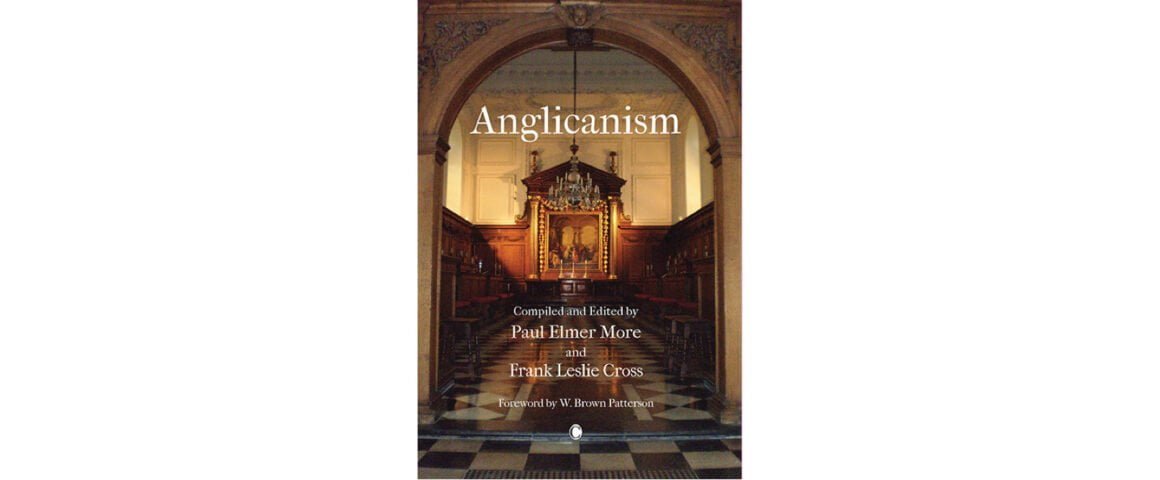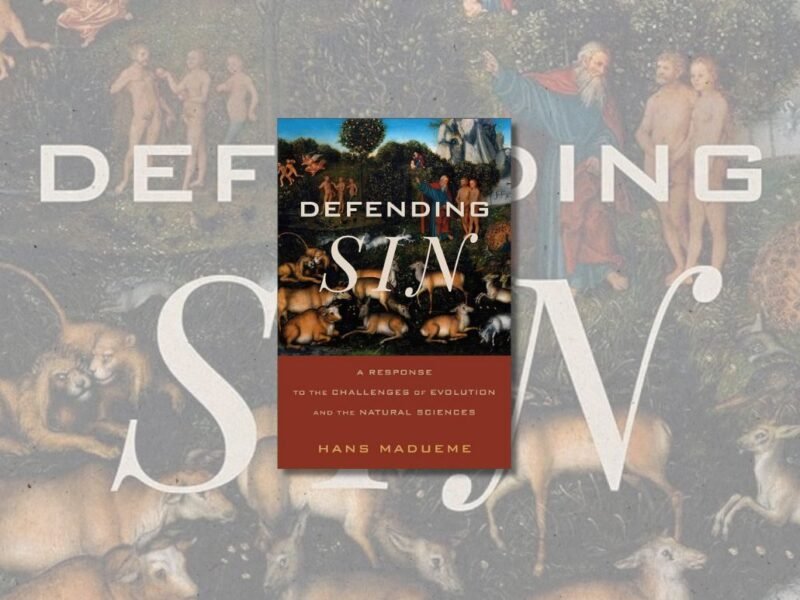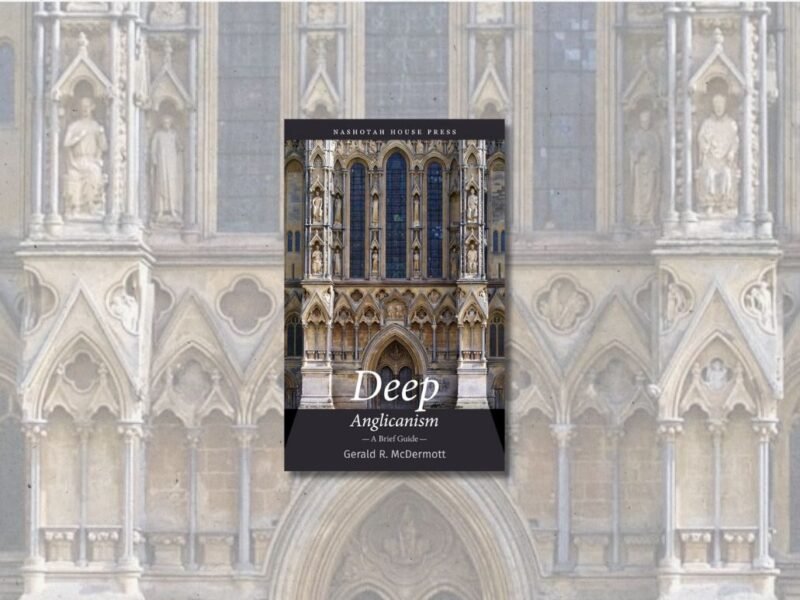Anglicanism: The Thought and Practice of the Church of England, Illustrated from the Religious Literature of the Seventeenth Century. Edited by Paul Elmer More and Frank Leslie Cross. Cambridge, UK: James Clarke & Co., 2009. 610 pp. $49.13 (paper).
In a video titled “Why I Am Not Anglican,” Lutheran pastor and author Dr. Jordan B. Cooper says his primary reason for not being Anglican is that “Anglicans don’t have doctrinal unity, and that’s really something I just can’t get behind” (3:35). Regrettably, theological diversity within Anglicanism has indeed transgressed acceptable limits, to the point that self-identified Anglicans differ even on fundamental tenets of the faith, to say nothing of second- or third-order concerns. Hence the protracted dispute in recent decades over what it means to be “Anglican.”
Yet despite the ever-growing longevity of this dispute, it is still meaningful to speak of a coherent Anglican tradition. Anglicanism: The Thought and Practice of the Church of England, Illustrated from the Religious Literature of the Seventeenth Century is proof of that.
As the title suggests, this book is an anthology of excerpts taken from the writings of various seventeenth-century Anglican thinkers and divines. Altogether they are meant to illustrate what Paul Elmer More—one of the editors of the volume—describes as “the specific genius of Anglicanism” (xxvii). Originally published in 1935, this collection has been reprinted multiple times, with the current edition first appearing in 2009. W. Brown Patterson writes in the foreword, “The current controversies over doctrinal and other issues in the worldwide Anglican Communion ‒ threatening its unity and effectiveness ‒ make a reprint edition of the book extremely welcome” (xvii).
While I have introduced this book as an answer to the charge that Anglicanism has no doctrinal center, it does contain “a considerable diversity of opinion” (xxvii). Indeed, Frank Leslie Cross—the volume’s other editor—observes that there are “side by side passages which give expression to opposing attitudes or beliefs” (lxvi). But as More points out, “An attentive student of the whole movement will be more impressed by the unity within the variety” (xxviii). This is especially evident in the book’s treatment of the fundamentals of Christianity, such as the Trinity, the Incarnation, and so on.
Still, it is probably a stretch to say, as Patterson does, that the book “resembles a summa theologica or systematic theology of the English Church” (xxiii). Rather, it is better considered as a general reference guide and introduction to many great Anglican thinkers and divines who have fallen into obscurity in our time. In addition to the standard subjects of theology (the Bible, the Church, the Sacraments, etc.), the book also addresses multiple topics that pertain specifically to Anglican thought and self-understanding. These include the nature and significance of episcopacy and apostolic succession, how the sacraments should be numbered, the practice of reserving the Eucharist, the value of auricular confession, and many others besides.
The fact that this book is an anthology, composed of myriad contributors who do not always agree, makes it difficult to give a detailed assessment of its substance. Nevertheless, I can safely say that its impressive scope and depth make it a fantastic resource. Every page will draw readers in, not just for the ideas themselves, but for the artful prose (and sometimes poetry) in which they are expressed. Not for nothing did T. S. Eliot write, “The publication of this book is an important event as much for literature as it is for theology.”
That said, I have two major criticisms, one mechanical and one substantive. The mechanical criticism is that the book’s Table of Contents is almost entirely inaccurate. To be precise, out of 368 total items, the page numbers listed in the Table of Contents for 296 of them (approximately 80%) are anywhere from 1‒5 pages off. This would be a serious oversight for any book, but for what is essentially a reference work it is an egregious failing, one that I earnestly hope the publisher will rectify in a future edition. In the meantime, interested readers should not allow this issue to deter them from making a purchase, as I have ascertained the actual page numbers for all of the incorrect Table of Contents entries—in the book every excerpt is listed in the Table of Contents as a numbered item, for example, “No. 2”—and have provided them below:
No. 2: 5
No. 4: 6
No. 6: 8
No. 8: 9
No. 9: 10
No. 25: 37
No. 32: 46
No. 33: 48
No. 35: 49
No. 44: 57
No. 46: 58
No. 53: 64
No. 55: 69
No. 56: 77
No. 59: 80
No. 67: 89
No. 69: 93
No. 72: 96
No. 84: 125
No. 85: 126
No. 87: 127
No. 89: 134
No. 90: 144
No. 91: 145
No. 92: 147
No. 93: 149
No. 94: 149
No. 95: 150
No. 96: 151
No. 97: 152
No. 98: 153
No. 99: 154
No. 100: 155
No. 101: 158
No. 102: 158
No. 103: 159
No. 104: 160
No. 105: 161
No. 106: 163
No. 107: 164
No. 108: 165
No. 109: 165
No. 110: 168
No. 111: 172
No. 112: 173
No. 113: 176
No. 114: 177
No. 115: 177
No. 116: 179
No. 117: 179
No. 118: 180
No. 119: 182
No. 120: 183
No. 121: 183
No. 122: 185
No. 123: 185
No. 124: 186
No. 125: 188
No. 126: 190
No. 127: 192
No. 128: 195
No. 129: 197
No. 130: 201
No. 131: 201
No. 132: 203
No. 133: 204
No. 134: 208
No. 135: 209
No. 136: 210
No. 137: 211
No. 138: 212
No. 139: 214
No. 140: 215
No. 141: 216
No. 142: 222
No. 143: 223
No. 144: 224
No. 145: 225
No. 146: 225
No. 147: 226
No. 148: 229
No. 149: 231
No. 150: 232
No. 151: 236
No. 152: 237
No. 153: 240
No. 154: 243
No. 155: 245
No. 156: 246
No. 157: 247
No. 158: 247
No. 159: 248
No. 160: 250
No. 161: 251
No. 162: 252
No. 163: 253
No. 164: 261
No. 165: 265
No. 166: 266
No. 167: 267
No. 168: 270
No. 169: 271
No. 170: 273
No. 171: 274
No. 172: 275
No. 173: 276
No. 174: 276
No. 175: 276
No. 176: 277
No. 177: 280
No. 178: 281
No. 179: 282
No. 180: 283
No. 181: 284
No. 182: 285
No. 183: 287
No. 184: 290
No. 185: 290
No. 186: 291
No. 187: 293
No. 188: 293
No. 189: 295
No. 190: 298
No. 191: 299
No. 192: 299
No. 193: 300
No. 194: 300
No. 195: 301
No. 196: 302
No. 197: 303
No. 198: 305
No. 199: 306
No. 200: 307
No. 201: 308
No. 202: 309
No. 203: 310
No. 204: 312
No. 205: 312
No. 206: 314
No. 207: 315
No. 208: 323
No. 209: 323
No. 210: 323
No. 211: 324
No. 212: 329
No. 213: 330
No. 214: 330
No. 215: 331
No. 216: 331
No. 217: 332
No. 218: 333
No. 219: 333
No. 220: 334
No. 221: 334
No. 222: 335
No. 223: 336
No. 224: 337
No. 225: 338
No. 226: 338
No. 227: 340
No. 228: 341
No. 229: 342
No. 230: 342
No. 231: 343
No. 232: 344
No. 233: 345
No. 234: 346
No. 235: 347
No. 236: 348
No. 237: 348
No. 238: 349
No. 239: 352
No. 240: 353
No. 241: 354
No. 242: 358
No. 243: 358
No. 244: 360
No. 245: 360
No. 246: 362
No. 247: 362
No. 248: 363
No. 249: 363
No. 250: 364
No. 251: 365
No. 252: 366
No. 253: 367
No. 254: 367
No. 255: 370
No. 256: 371
No. 257: 372
No. 258: 372
No. 259: 373
No. 260: 374
No. 261: 377
No. 262: 380
No. 263: 381
No. 264: 381
No. 265: 382
No. 266: 383
No. 267: 384
No. 268: 385
No. 269: 389
No. 270: 400
No. 271: 402
No. 272: 402
No. 273: 403
No. 274: 405
No. 275: 406
No. 276: 407
No. 277: 407
No. 278: 408
No. 279: 409
No. 280: 410
No. 281: 411
No. 282: 411
No. 283: 411
No. 284: 415
No. 285: 416
No. 286: 418
No. 287: 420
No. 288: 421
No. 289: 421
No. 290: 422
No. 291: 422
No. 292: 423
No. 293: 423
No. 294: 424
No. 295: 425
No. 296: 425
No. 297: 426
No. 298: 426
No. 299: 426
No. 300: 427
No. 301: 428
No. 302: 428
No. 303: 431
No. 304: 432
No. 305: 433
No. 306: 433
No. 307: 434
No. 308: 436
No. 309: 440
No. 310: 441
No. 311: 441
No. 312: 442
No. 313: 442
No. 314: 443
No. 315: 445
No. 316: 445
No. 317: 446
No. 318: 447
No. 319: 449
No. 320: 451
No. 321: 451
No. 322: 452
No. 323: 454
No. 324: 457
No. 325: 459
No. 326: 459
No. 327: 461
No. 328: 461
No. 329: 462
No. 330: 462
No. 331: 463
No. 332: 464
No. 333: 466
No. 334: 466
No. 335: 477
No. 336: 482
No. 337: 483
No. 338: 484
No. 339: 488
No. 340: 489
No. 341: 490
No. 342: 492
No. 343: 493
No. 344: 494
No. 345: 506
No. 346: 507
No. 347: 508
No. 348: 508
No. 349: 509
No. 350: 509
No. 351: 510
No. 352: 511
No. 353: 513
No. 354: 515
No. 355: 515
No. 356: 516
No. 357: 516
No. 358: 518
No. 359: 519
No. 360: 519
No. 361: 521
No. 362: 522
Biographies in Outline: 524
The substantive criticism has to do with this anthology’s larger answer to the question, “What is Anglicanism?” On this score, the included excerpts speak for themselves, and—with a few minor exceptions—I have nothing to say against them. Unfortunately, one of the volume’s editors, Paul Elmer More, felt the need to inject his own thoughts on what these collected writings tell us about the essence of Anglicanism. His assessment, quite unlike the collected writings themselves, would be better left buried and forgotten.
According to More, one of the defining characteristics of Anglicanism is “the axiomatic rejection of infallibility” (xxxi). In the book’s excerpts, this rejection is directed toward individual churches, councils, and methods or institutions of biblical interpretation. More, however—taking for granted “the results of modern Biblical scholarship” (xxxiv)—raises the question of whether the seventeenth-century divines, if confronted with the “evidence of critical examination” (xxxv), would have been willing to apply their rejection of infallibility even to the Bible itself. The answer, says More, determines “whether the Church can be said to have moved in a straight direction, whether, in a word, it is proper to speak of any such thing as Anglicanism” (xxxv).
That is to say, in More’s view, the ongoing continuity of Anglicanism hinges on our ability to take up the seventeenth-century divines’ rejection of infallibility as applied to any “created power” (xxxv) and recognize that such created powers include the Bible itself. More notes that the Oxford Movement, inheritor of this “liberal spirit of the seventeenth century” (xxxvi), was able to do so, as exemplified by the landmark collection of essays titled Lux Mundi.[1] Accordingly, More continues, the “ultimate law of Anglicanism” is “pragmatism” (xxxvii). On this account, when considering the truth of doctrines such as the Incarnation we should ask ourselves “the consequences of believing or not believing. How does acceptance of the dogma of the Incarnation work out in practice? Does faith bring with it any proof of its objective validity?” (xxxvii) In this way, “The experiment of believing may pass into experience,” and experience in turn will give rise to “conviction,” all “without leaning for support on the theory of an oracular infallibility committed to any visible organ of speech” (xxxviii). More hopes that a “liberal ethos of Christianity” much like this will “more and more prevail in the Holy Catholic Church [i.e., all of Christendom]” (xlii, italics original).
Such a “liberal ethos” certainly has prevailed in much of Christianity today, especially in the West. But we can only hope that More—had he enjoyed the opportunity to observe the development of Anglicanism in the century since his death in 1937—would have reconsidered his confidence that this liberal spirit would spare Anglicanism from the fate of “radical Protestants,” who “have seen their faith in the fundamentals of religion go down to ruins along with their anti-catholic bibliolatry” (xxxvi). For by this criterion we see that, pragmatically speaking, More’s vision of Anglicanism is as “hopelessly out of court” as he judged the “radical Protestants” to be for clinging to “an impossible theory of Scriptural inerrancy” (xxxvi).
To reiterate, though, the authors collected in this volume speak for themselves. Readers who pick it up will hear a strong and clear voice answering the question of “What is Anglicanism?” That voice speaks of a faith that is at once catholic and reformed—in the words of King James I, catholic in its acceptance of “the Scriptures, the three Creeds, and…the four first General Councils,” yet reformed in its rejection of “novelties” (4). As a collection of seventeenth-century primary sources, the book does not address that account of Anglicanism propagated by the Tractarians and their heirs. But to the extent that it represents what proponents have called classical Anglicanism, it remains an important resource in this ongoing definitional endeavor.
Notes
- Amusingly, More singles out John Henry Newman as a retrograde influence on the Oxford Movement who, for all his “genius,” was “not without danger of leading the Church away from the line of its normal development” as a result of his biblical “fundamentalism” (xxxvi). ↑







'Book Review: “Anglicanism”' has 1 comment
May 20, 2022 @ 11:55 am Isaac Rehberg
IIRC Moore\’s statement are part of his \”Spirit of Anglicanism\” essay in the introduction. That was the first piece we looked at on the Miserable Offenders Podcast (and indeed, I think the only one we did in its intirety). I remember getting increasingly annoyed with that kind of thing as we went through the essay!